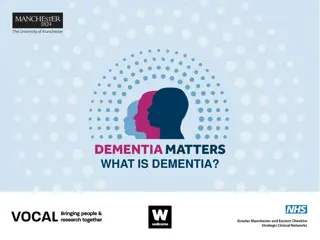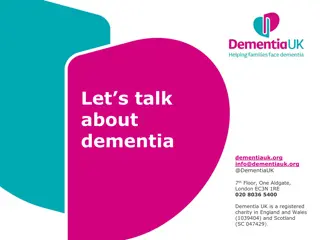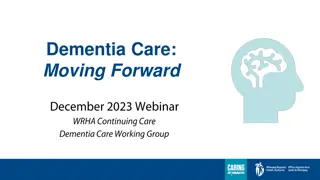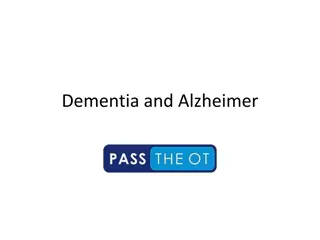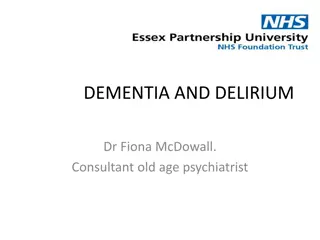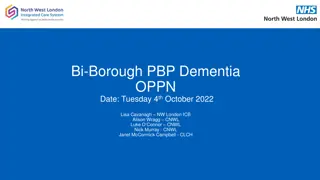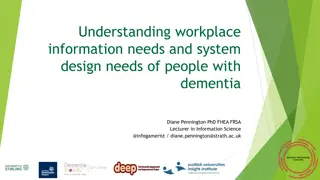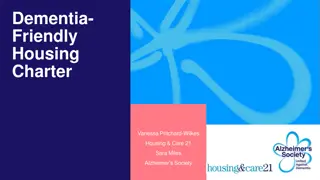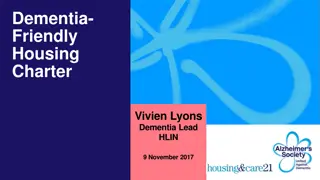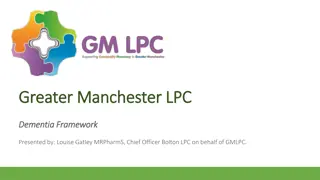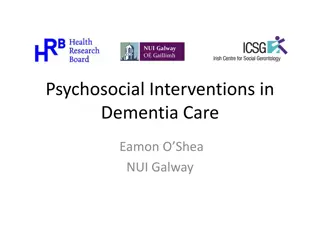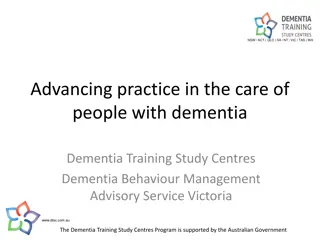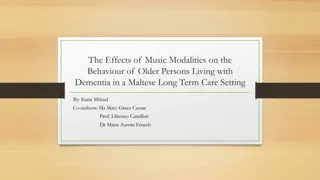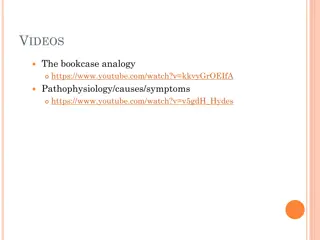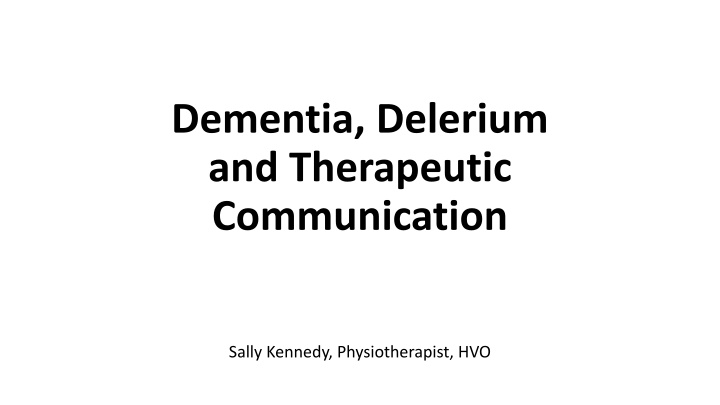
Dementia, Delirium, and Therapeutic Communication
Explore the types and causes of dementia, differentiate between dementia, delirium, and normal aging, and learn about symptoms of dementia affecting therapy interventions. Reflect on effective communication, consider a holistic approach to supporting individuals with dementia, and discuss scenarios. Discover the incidence and prevalence of dementia, life expectancy after diagnosis, and common causes. Gain insights into the different types of dementia and their symptoms.
Download Presentation

Please find below an Image/Link to download the presentation.
The content on the website is provided AS IS for your information and personal use only. It may not be sold, licensed, or shared on other websites without obtaining consent from the author. If you encounter any issues during the download, it is possible that the publisher has removed the file from their server.
You are allowed to download the files provided on this website for personal or commercial use, subject to the condition that they are used lawfully. All files are the property of their respective owners.
The content on the website is provided AS IS for your information and personal use only. It may not be sold, licensed, or shared on other websites without obtaining consent from the author.
E N D
Presentation Transcript
Dementia, Delerium and Therapeutic Communication Sally Kennedy, Physiotherapist, HVO
Aims to understand types and causes of dementia recognise difference between dementia, delirium and normal ageing and other confusional states explore symptoms of dementia and how these may effect therapy intervention explore effective therapy intervention with people dementia
Reflect on effective communication with people with dementia Consider implications of a holistic, person-centred approach to supporting people with dementia discuss scenerios
Incidence Prevelence increases with age Estimates range from around 2.5% for age 65+ 10-20% for age 75+ 20-50% for age 85+ However, even in late old age, there are more people who do not have dementia than those who do.
Life expectancy varies from 2 10+ years from initial diagnosis Complications and comorbidities such as respiratory and cardiovascular problems are more common cause of fatality Social, psychiatric and behavioural factors also play a significant part in illness and eventually mortality eg: o non-compliance with medication and other interventions o dietary changes and weight loss o depression and loss of motivation
Causes and types of dementia Alzheimer s disease (55%) Vascular dementia (20%) Dementia with Lewy Bodies (15%) Fronto-temporal dementia (5%) other dementia s (5%) o eg Korsakoff s syndrome, CJD, MS, MND
Symptoms of dementia Impaired reasoning Disinhibited behaviour Movement and co-ordination problems Incontinence (in later stages) Hallucinations (rather than misunderstandings eg mistaking own reflection in mirror for another person etc) Memory loss Loss of sense of time/place Loss of awareness Loss of ADL s Word-finding difficulties Recognition problems (eg objects, people)
Delerium Definition an acutely disturbed state of mind characterized by restlessness, illusions, and incoherence, occurring in intoxication, fever, and other disorders is acute change is reversible characterised by may affect attention, concentration, motivation Hypoactivity (most common), Hyperactive, Mixed
Potential causes of acute delerium Infection Medication Electrolyte disturbance Dehydration Constipation Post Anaesthesia/surgery Post stroke Pain
Other conditions that may cause confusional states - physical and psychological physical and psychological Chest and urinary tract infections Vitamin B12 deficiency (? Severe anaemia) Thiamine deficiency (? Poor diet and/or alcohol misuse) Diabetes or thyroid deficiency Excessive alcohol consumption Heart, kidney, liver or respiratory disease Dehydration
Constipation Stroke, TIA s or head injury Hypothermia Trauma following fracture or surgery Sleep disturbance Environmental changes eg going into hospital or moving house Depression or bereavement reactions Brain tumour (adapted from Stokes and Goudie, 2002)
Person-centred approach Don t ask what disease the person has, but rather what person the disease has (Oliver Sacks) Don t think about the person with dementia but think about the person with dementia
Person-centred care Developed by Prof Tom Kitwood at University of Bradford in 1988 other factors, not just the progressive damage in the brain, have a bearing on how a person experiences dementia Personhood = a standing or a status that is bestowed on one human being, by another in the context of relationship and social being and is transcendent, sacred and unique
Holistic perspective Neurological impairment the physical damage to neurones in different areas of the brain Personality including temperament, coping style and psychological defences Biography life history Physical health including functioning senses like vision and hearing Social psychology their relationships, interactions, occupation and care
identity occupation attachment LOVE inclusion comfort
Person-centred care We all have a need to feel: to feel respect from others to be in communication with others to feel useful to feel in control to be active and involved in life to have choices to make decisions Lack of these leads to erosion of personhood = decline
Physiotherapeutic approach Consider how can we add to the persons feelings of attachment, occupation, identity etc Consider ways to engage the patient using functional tasks Use all 5 senses to make activities more meaningful
Differing perspectives A person with dementia may have a very different reality from yours eg: Where does the person believe they are? Who do they believe you to be? What do they believe you are saying? How the room may appear (? agnosia) What sounds or words they might be hearing
Scenario You are in an unfamiliar room with some white furniture and other items that you don t recognise in one corner A person comes over to you and starts to speak to you in a language that you don t understand Suddenly there is a rushing noise coming from one side of the room and the person starts to try to take off your clothes You start to protest, but they don t seem to understand and ignore your protestations How do you feel? What would you do?
Communication Strategies Reduce distractions e.g. turn off radio or radio/pull curtain round. Stand or sit by their eye level. Gain their full attention before speaking with them (use touch, obtain eye contact). Identify yourself and call them by their name. Redirect attention if the person is tense or distracted. Remind them of what they have just said. Use short sentences and give directions one step at a time from one person at a time Slow speech down slightly - people may be more receptive to a low-pitched, quieter voice. Try different ways of saying the same thing. Don t change subject too quickly. Use gestures to demonstrate what you are saying or point to relevant objects/body parts to supply additional info. Ask questions that require a yes/no answer or offer a choice between two items. Try not to interrupt when he/she is trying to communicate an idea as this may cause them to lose their train of thought. Don t contradict or argue. Be sensitive and try to understand the motivation behind what they are saying. eg If they say they are waiting for their mother this may be as they are feeling lonely, insecure and fearful. Give plenty of time for the person to process the information and formulate a response.
Therapeutic Communication Collude or contradict? Exercise: What do you say to an older person with dementia who asks you if you can help her find her mother when you know that her mother has passed away many years previously? What might this person be feeling? What are they trying to communicate to you?
Empathy Exercise I am talking, talking all the while. I didn t know if you would understand with you being on the other side. What might this person be trying to express to the listener? How might you respond? Discuss the pitfalls and advantages of distraction, collusion and other techniques. Can you share any examples from your clinical practice?
Feedback your discussions to the group Any Questions?

